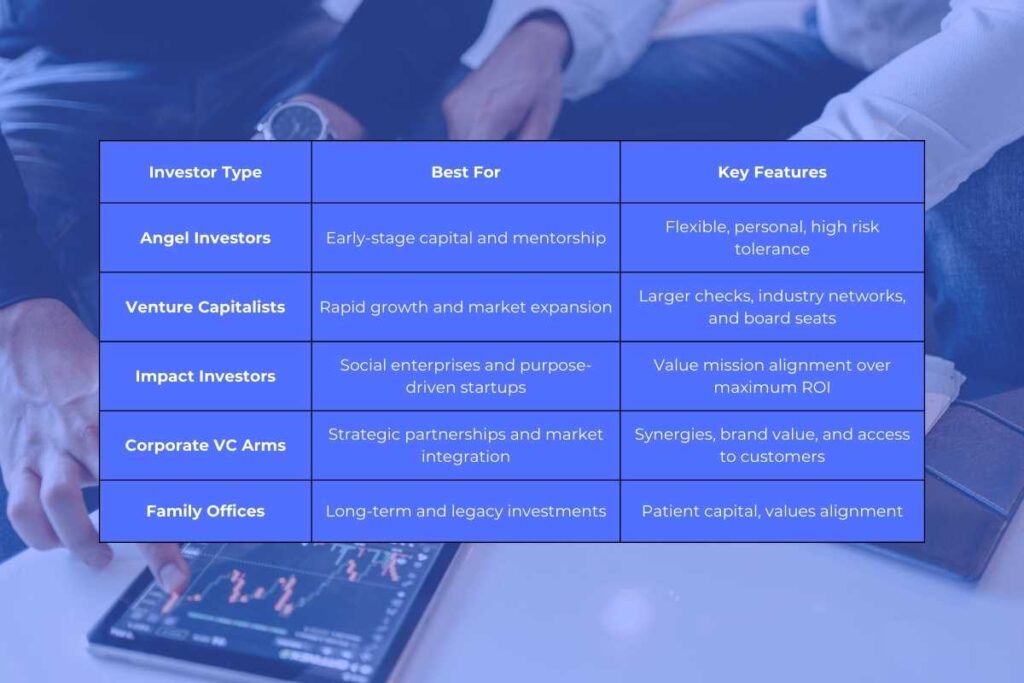Beyond the Check: Why the Right Investor Matters
Attracting investment is one of the most critical milestones in a startup’s journey. But while many entrepreneurs focus solely on raising capital, the smartest founders know that not all money is created equal. Choosing the right investor can mean the difference between sustainable growth and mission drift.
Investors bring more than just funds; they offer mentorship, networks, industry experience, strategic advice, and often a say in company decisions. That’s why finding the “right” investors, not just any investors, is key to scaling your startup with purpose, speed, and integrity.
In this article, we’ll explore how to identify and attract investors for your startup who align with your startup’s vision, values, and growth strategy. From refining your pitch to cultivating relationships, this guide will help you turn investor meetings into meaningful partnerships.
1. Know What You Need (And Why You Need It)
Before seeking investors, it’s essential to understand why you’re raising capital and what you intend to do with it.
Ask yourself:
- Are you trying to build a prototype, scale your team, or enter new markets?
- How much capital do you need, and how long will it last?
- What kind of investor involvement are you looking for, hands-on or hands-off?
Pro Tip: Your funding needs should match your stage of growth. Early-stage startups might look for angel investors or pre-seed VCs, while later-stage companies might approach institutional investors or corporate venture arms.
Being clear on your goals will help you target the right investor profile and avoid partnerships that may push your business in the wrong direction.
2. Define the “Right” Investor for You
An ideal investor does more than just write checks. They:
- Understand your industry
- Share your vision and values
- Provide strategic guidance
- Offer relevant networks
- Respect your leadership and decisions
Here are common types of investors and what they typically bring:

| Investor Type | Best For | Key Features |
| Angel Investors | Early-stage capital and mentorship | Flexible, personal, high risk tolerance |
| Venture Capitalists | Rapid growth and market expansion | Larger checks, industry networks, and board seats |
| Impact Investors | Social enterprises and purpose-driven startups | Value mission alignment over maximum ROI |
| Corporate VC Arms | Strategic partnerships and market integration | Synergies, brand value, and access to customers |
| Family Offices | Long-term and legacy investments | Patient capital, values alignment |
Choose investors who complement your vision, not conflict with it.
3. Build an Investable Business First
You can’t attract great investors without a solid foundation. Your startup must show traction, potential, and credibility.
Key elements to focus on:
- Product-Market Fit: Are you solving a real problem with a scalable solution?
- Validation: Do you have paying customers, positive feedback, or strong user metrics?
- Business Model: Is your revenue model clear, scalable, and sustainable?
- Team: Is your leadership team capable, committed, and well-rounded?
- Vision: Is your mission compelling and your roadmap convincing?
Creative Edge: Build an impressive digital presence, have a professional website, updated LinkedIn profiles, and a strong brand identity. These small details can influence investor perception significantly.
4. Craft a Pitch That Resonates
Your pitch isn’t just about numbers. It’s a narrative, a story about vision, pain points, innovation, and opportunity.
What to Include in Your Pitch Deck:
- Problem: What real, urgent issue are you solving?
- Solution: Why is your product or service the answer?
- Market Opportunity: How big is the market? Is it growing?
- Business Model: How do you make money?
- Traction: Show evidence of progress and results.
- Team: Highlight your people and their qualifications.
- Go-to-Market Strategy: How will you acquire customers?
- Financials: Include projections and key metrics.
- The Ask: How much are you raising, and what will it be used for?
- Vision: Where are you headed in the long term?
Tip: Tailor your pitch to each investor. Research their portfolio and values beforehand to align your presentation with their interests.
5. Find Investors Through the Right Channels
Finding investors is not just about sending cold emails. It’s about strategic networking and positioning.
Places to Look:
- Startup incubators and accelerators (e.g., Y Combinator, Techstars)
- Pitch events and demo days
- Angel networks (e.g., AngelList, TiE)
- Venture capital firm websites
- LinkedIn and Twitter
- University entrepreneurship centers
- Online platforms like Gust, SeedInvest, and Crunchbase
Relationship Building Is Key: Investors often invest in people they trust. Start building relationships early, even before you start raising. Share updates, ask for advice, and build rapport. Fundraising is often about who knows you, not just what you’re building.
6. Position Yourself as a High-Value Opportunity
To attract top-tier investors, you need to stand out. Here’s how:
- Create FOMO (Fear of Missing Out): Mention other interested parties (if any), progress made, or exclusivity.
- Demonstrate Momentum: Regular updates showing growth, partnerships, or media coverage can boost credibility.
- Highlight Defensibility: Show why your product can’t be easily copied, through IP, technology, brand, or network effects.
- Be Coachable and Confident: Investors like founders who can lead, listen, and adapt.
Investor’s Perspective: They are not just betting on an idea, they’re betting on you. Show passion, resilience, and a clear vision for the future.
7. Screen Investors as Much as They Screen You

Just like dating, not every match is made in heaven. Ask yourself:
- Does this investor align with our company’s mission?
- What’s their reputation with other founders?
- Do they have experience in our industry?
- Are they looking for long-term impact or short-term exits?
- What value (beyond money) can they bring?
Pro Tip: Talk to other portfolio founders before accepting an offer. Their experiences can reveal a lot about an investor’s true style.
8. Negotiate Smart, Not Desperate
When you find the right investor, the final step is negotiation. Be prepared to discuss:
- Valuation
- Equity stake
- Control terms (board seats, veto rights)
- Vesting schedules
- Follow-on investment rights
Don’t undervalue your startup just to close a deal. At the same time, avoid overvaluation that can hurt future rounds. Fair, transparent negotiation leads to healthier long-term relationships.
Red Flags to Watch:
- Excessive control or micromanagement clauses
- Pressure for quick exits
- Misalignment on mission or vision
9. Keep the Relationship Alive Post-Investment
The investor-founder relationship doesn’t end with a wire transfer. That’s where it begins.
- Communicate regularly with updates, both good and bad.
- Seek advice, not just funding.
- Leverage their network to make key hires, find partners, or enter new markets.
- Be transparent when facing challenges.
Investors who feel respected and involved are more likely to become champions for your brand, helping with follow-on rounds and introductions to future investors.
10. Stay Mission-Focused and Long-Term Oriented
In the pursuit of funding, don’t lose sight of your core mission. The wrong investors can push you to prioritize short-term profits over long-term purpose, or growth over sustainability.

Ask yourself:
- Will this investor help us build something meaningful?
- Can we grow with integrity and impact under their influence?
Remember, the right investor is a partner, not just a financier. They believe in your potential, share your values, and want to help you succeed in every sense, not just financially.
Conclusion: Strategic Capital for Purposeful Growth
Attracting the right investors for your startup is as much about strategic fit as it is about funding. It requires clarity, confidence, and patience. It’s about building a business that not only excites but inspires. That not only scales but sustains. That not only profits but also creates value.
By focusing on alignment, storytelling, traction, and relationship-building, your startup can attract investors who will help you grow wisely, not just rapidly.
So, don’t just pitch for capital. Pitch for partnership.
Because the best investors for your startup don’t just fund your dream, they help you realize it.

